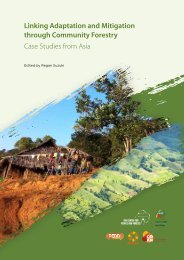Desktop Study on - Regional Climate Change Adaptation ...
Desktop Study on - Regional Climate Change Adaptation ...
Desktop Study on - Regional Climate Change Adaptation ...
You also want an ePaper? Increase the reach of your titles
YUMPU automatically turns print PDFs into web optimized ePapers that Google loves.
Assessment of Capacity Gaps and Needs of South East Asia Countries<br />
in Addressing Impacts, Vulnerability and Adaptati<strong>on</strong> to <strong>Climate</strong> Variability and <strong>Climate</strong> <strong>Change</strong><br />
measures in the different levels of implementati<strong>on</strong>.<br />
The differences dem<strong>on</strong>strate the str<strong>on</strong>g influence<br />
that the local c<strong>on</strong>text has <strong>on</strong> climate risk management.<br />
The measures that are used and their effectiveness<br />
are place and time specific, but all these acti<strong>on</strong>s<br />
are developed into what is d<strong>on</strong>e at community and<br />
nati<strong>on</strong>al levels. Farmers and local level do not have<br />
a comprehensive evaluati<strong>on</strong> of nati<strong>on</strong>al policies<br />
and programs. At nati<strong>on</strong>al level, measures, which<br />
farmers are aware, do not take part in the nati<strong>on</strong>al<br />
strategy process for managing climate risks. The<br />
acti<strong>on</strong>s are not coordinated and typically are not<br />
designed specifically to combat climate risks. Also,<br />
investment costs and limited financial capacity of<br />
farmers to implement their measures to fight against<br />
climate change, limits wider use of these measures.<br />
Recent Projects in the Agriculture<br />
and Food Sector<br />
In additi<strong>on</strong> to the efforts that the Government is<br />
doing, tasking the MARD and the MoNRE with the<br />
policies and programs to address climate change<br />
issues, NGOs, community groups and other civil<br />
society organizati<strong>on</strong>s are working directly with<br />
the grassroots level and play an important role<br />
for minimizing the negative impacts of climate<br />
change. In accordance with this, Sustainable<br />
Rural Development (SRD), a development agency<br />
supporting poor rural communities, is implementing<br />
projects focused in sustainable agriculture and<br />
livelihoods in mountainous areas affected by climate<br />
change, integrating climate c<strong>on</strong>cerns at the local level<br />
projects. SRD projects <strong>on</strong> rice seed c<strong>on</strong>servati<strong>on</strong> are<br />
the System of Rice Intensificati<strong>on</strong>, Participatory Land<br />
Use Management, and Integrated Pest Management;<br />
all have c<strong>on</strong>tributed to the adaptati<strong>on</strong> of the rural<br />
communities to the risk of climate change and the<br />
minimizati<strong>on</strong> of the harmful effects (SRD, 2009).<br />
The World Bank’s matrix of climate change activities<br />
(World Bank, 2009b) also provides a list of projects<br />
related with the agricultural sector; some of these<br />
are: (i) The project Ec<strong>on</strong>omics of Adaptati<strong>on</strong> to<br />
<strong>Climate</strong> <strong>Change</strong> (EACC) - Agriculture and Water<br />
sector study in Viet Nam, that has already been<br />
described in the water sector; (ii) Australia/AusAID<br />
is funding the project “Helping poor farmers in ricebased<br />
systems in the Mek<strong>on</strong>g delta of Viet Nam adapt<br />
to climate change” which is being implemented by<br />
ACIAR and that supports targeted research and<br />
development collaborati<strong>on</strong> between Viet Nam<br />
agencies, Australian organisati<strong>on</strong>s and internati<strong>on</strong>al<br />
agricultural research centres to improve adaptati<strong>on</strong><br />
to climate change for small farmers in the Mek<strong>on</strong>g<br />
Delta (World Bank, 2009b).<br />
Socio-Ec<strong>on</strong>omic Sector<br />
Range of Studies Reviewed and<br />
Methods Applied<br />
A World Bank Policy Research Paper studied the<br />
c<strong>on</strong>sequences of a sea level rise of 1 - 5 meters <strong>on</strong><br />
84 developing countries, including Viet Nam. The<br />
method adopted included the use of GIS software,<br />
overlaid with spatially-disaggregated global data<br />
sets <strong>on</strong> land, populati<strong>on</strong>, agriculture, urban extent,<br />
GDP, and wetlands, obtained from various public<br />
sources such as the Center for Envir<strong>on</strong>mental<br />
Systems Research and the World Bank (Dasgupta et<br />
al., 2007).<br />
Chaudry and Ruysschaert (2007) edited the Human<br />
Development Report 2007/2008 and provided the<br />
most relevant study reviewed regarding the socioec<strong>on</strong>omic<br />
vulnerability and adaptati<strong>on</strong> strategies<br />
undertaken. Chaudry and Ruysschaert (2007)<br />
addressed the topic of climate change and human<br />
development in Viet Nam through studying existing<br />
reports and data from literature.<br />
The Viet Nam Academy of Social Sciences (VASS,<br />
2007) c<strong>on</strong>stituted a nati<strong>on</strong>al source of informati<strong>on</strong><br />
regarding Viet Nam’s poverty c<strong>on</strong>diti<strong>on</strong>s. The report<br />
used findings from literature research and analyzed<br />
data from the Viet Nam Household Living Standards<br />
Surveys in 1993, 1998, 2002 and 2004.<br />
Finally, a recently published report of Oxfam (2008)<br />
assessed the situati<strong>on</strong> of the poor populati<strong>on</strong> and<br />
their adaptati<strong>on</strong> strategies through a field study in<br />
the two provinces of Ben Tre and Quang Tri in May<br />
2008.<br />
Socio-Ec<strong>on</strong>omic Impacts<br />
<strong>Climate</strong> change is c<strong>on</strong>sidered to be a `real threat´ to<br />
further pursuing socio-ec<strong>on</strong>omic development of<br />
Viet Nam, in view of an increase in the variability<br />
in rainfall, higher temperatures and intensity of<br />
extreme weather events, and sea level rise (Dasgupta<br />
et al., 2007).<br />
For Viet Nam the c<strong>on</strong>sequences of sea level rise are<br />
`potentially catastrophic´(Dasgupta et al., 2007).<br />
Am<strong>on</strong>g the 84 studied developing countries, Viet<br />
Nam shows the highest percentage of the populati<strong>on</strong><br />
that would be affected by a sea level rise of 1 meter,<br />
being 10.8%. With a projected sea level rise of 5<br />
meters, the impacted populati<strong>on</strong> would even amount<br />
to 35%. A sea level rise of 1 meter is expected to<br />
reduce Viet Nam’s GDP by approximately 10% (35%<br />
in the case of 5 meter), impact the urban extent by<br />
41

















